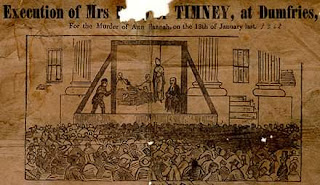Mary Timney - for the murder of her neighbour.
Mary Timney - for the murder of her neighbour.
On Tuesday the 29th of April 1862, 27 year old Mary Timney became the last woman to be publicly hanged in Scotland. She was executed at 8.15 a.m. on a gallows borrowed from Edinburgh and erected at the junction of St David Street (now Irish Street) and Buccleuch Street outside the prison in Dumfries, before a crowd of some 3,000 people.
Mary lived in a cottage on a small farm owned by 40 year old Ann Hannah at Carsphad, near the eastern edge of what is now the Galloway Forest Park. Her cottage was just 50 yards from the farmhouse where Ann lived with her two brothers, Lockhart and William. It appears that the two women did not get on well and that there was a problem with Mary frequently trying to borrow money from Ann. Ann also accused Mary of stealing wood from her.
Things came to a head on the morning of the 13th of January 1862 when Mary attacked Ann in her own home and beat her to death, after her brothers had left for work. Ann was discovered by a lady named M’Lellan around 1 p.m., lying on the floor in a pool of blood, barely clinging to life. A butcher's knife and a two-foot long fire poker, both covered in blood were found in the room. Ann died that evening and the post-mortem discovered four fractures of the skull, two broken ribs and discolouration of the arms.
Mary was the prime suspect and was identified by witnesses as having been in the vicinity carrying a mallet and having blood stained clothes. When the police searched her cottage, they found the bloodied clothing hidden in the loft and the mallet with blood and hair on it. She was arrested and claimed that Ann had started the fight by kicking her and that she used the weapons that were to hand in self defence.
She came to trial in early April at Dumfries before Lord Deas. It took the jury just half an hour to unanimously find her guilty of murder. Lord Deas donned the black cap in preparation to pass sentence of death, causing Mary to exclaim “No, my lord, give me forever a prison - dinna, dinna do that!". He continued to sentence her, causing her to break into tears.
Strangely after the trial there was substantial public sentiment in favour of a reprieve for Mary, with public meetings and newspaper articles, criticizing the "brutalising tendency of legalised strangling". It was reported that: "The great majority of the public of Dumfries were horrified and indignant that this butchery should be permitted in their streets."
The MP for Dumfries, William Ewart, a well known anti death penalty campaigner, was urged to take the case to the Home Secretary of the day, Sir George Grey. 3,187 women signed a petition for a reprieve. On the 24th of April Sir George gray announced that the “law must take its course”.
William Calcraft had travelled up from London on the Monday and made the usual preparations. On the Tuesday, Mary was led to the “New Drop” gallows in a state of near collapse, crying out "Oh my four weans (babies), oh my four weans, oh, oh, oh."
It took about a minute for her body to become still after the drop fell. This broadside of the execution was published.
The Dundee Courier newspaper recorded the arrangements made for the four children.
The eldest, 8 year old Susan was placed in the care of a “philanthropic lady in Bristol” and the three younger children were sent to an Industrial Home where they were to receive an education and vocational training.











Comments
Post a Comment